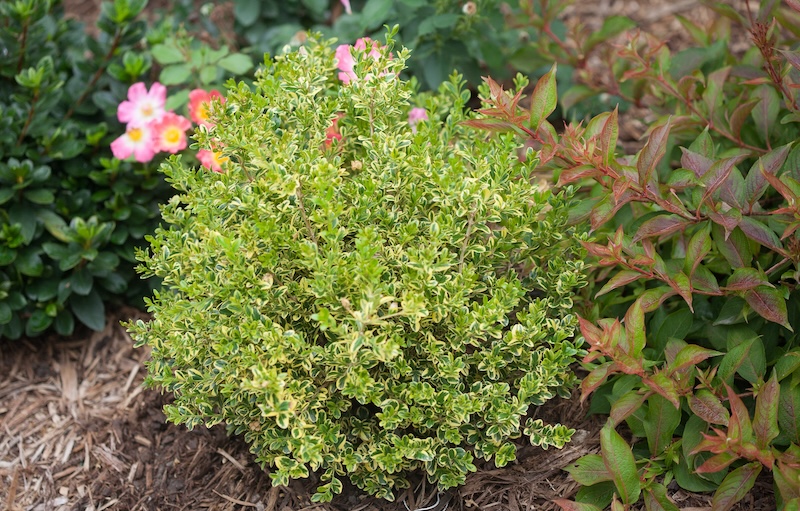Boxwoods are small trees or shrubs in the genus Buxus. These plants are popular for their glossy, evergreen leaves and neat, structured form. Boxwoods are extremely versatile in the landscape, acting as specimen plants or backdrops for flowering plants. These broadleaf shrubs respond well to shaping and trimming, making them excellent for topiary gardens. Additionally, boxwoods are ideal for hedges, borders, and formal gardens. With numerous varieties available, there is a boxwood for every garden.

While boxwood tolerates partial shade, it should be planted where it will receive at least 6 hours of sunlight per day. Boxwood does not need to be watered often once established. It thrives in neutral, well-drained soils, such as sandy or loamy soil. Like many evergreens, boxwood is subject to desiccation from harsh winter winds. Plant it in a protected site and water it well before and during winter to prevent its leaves from turning brown.
Boxwood will survive in zones 4-9, providing year-round color to landscapes. Boxwood typically grows from 4-15 feet tall and 6-10 feet wide, while dwarf varieties can grow to just 1-3 feet tall. These slow-growing evergreens pair well with many plants in the garden due to their year-round interest and well-behaved, low-maintenance nature.
Shrubs To Plant With Boxwood
With its evergreen leaves and versatile form, boxwood grows wonderfully with other shrubs in mixed hedges and borders. For a long-lasting display of color, plant boxwoods with shrubs that bloom at different times. Grow a fragrant, colorful border with shrubs such as lilacs and roses. Lilacs will provide spikes of sweet-scented blossoms in spring, while many varieties of roses, such as floribunda roses, will bloom continuously from summer to fall. Other flowering shrubs to grow with boxwood are spirea and ninebark for pretty clusters of flowers.

For year-round color, evergreen shrubs such as nandina and privet can be grown with boxwood as a mixed privacy hedge or as a living fence. Where nandina and privet are invasive, consider growing coniferous evergreens such as juniper and arborvitae, which are available in many sizes, colors, and forms.
Perennials To Plant With Boxwood
Boxwood provides an excellent green backdrop for numerous perennials. Bulbs such as tulips or daffodils will provide vibrant spring color and create a classic, formal look when planted in front of boxwood. Plant perennials such as columbine and hellebore to continue the spring display of flowers in shadier spots. For a stately, elegant planting, consider growing peonies and boxwood together. The large, eye-catching blooms of peonies will provide a nice contrast to the shiny green foliage of boxwood.
To create a variety of interest in the landscape, grow boxwood with perennials that will provide different textures. For example, the tall, wispy flower spikes of Russian sage, lavender, and false indigo will complement the more manicured, mounded form of boxwood. In addition, low-growing ground covers such as wild ginger or creeping thyme will fill in nicely around boxwood and other perennials for a full, lush planting.
Annuals To Plant With Boxwood
Growing annuals with boxwood allows you to try out new landscape designs year after year. Smaller flowering annuals such as petunias and verbena will provide long-lasting color to your boxwood plantings. For shadier gardens, consider planting begonias, which offer a wide variety of foliage and flowers to brighten your landscape. Since boxwoods provide a neutral, evergreen backdrop for annuals, you can also try growing bold and interesting annuals such as celosia for intriguing feathery or crested blossoms.
Best Companion Plants For Boxwood in Containers
Boxwood is one of the best shrubs to grow in containers, as it can easily be pruned into various shapes for endless container design options. Acting as the main focal point in containers, boxwood looks good with filler annuals and perennials such as petunias, coral bells, and coleus – the latter two plants will also provide colorful and interesting foliage. Ornamental grasses can be planted with boxwood in containers for a stark contrast in textures and form. Plant evergreen trailing plants such as English ivy for a complete container design that will stay green even in the winter.

Plants Not To Grow With Boxwood
Since boxwood grows best in neutral soils, it should not be grown with plants that prefer more acidic soil. Although it may be tempting to create an evergreen border with popular shrubs such as rhododendrons and mountain laurel, these acid-loving plants may not thrive in the neutral soils that boxwood prefers. Additionally, do not plant boxwood under the shade of large trees where it will receive less than 6 hours of sunlight per day. Doing so can result in poor growth and higher susceptibility to boxwood blight.
Best Plants To Grow With Boxwood
The best plants to grow with boxwood are plants that prefer neutral, well-drained soil. Grow boxwood with flowering shrubs and perennials such as lilacs, roses, ninebark, spirea, peonies, hellebores, tulips, and daffodils for a colorful landscape. Incorporate different textures into your garden by using airy plants such as Russian sage, false indigo, and ornamental grasses. Create an evergreen garden by planting boxwood with nandina, arborvitae, and juniper. Grow annuals like petunias, begonias, and verbena with boxwood in gardens and containers for vibrant, versatile designs.
 |
Lauren Youngcourt - Published 11-22-2023 |
